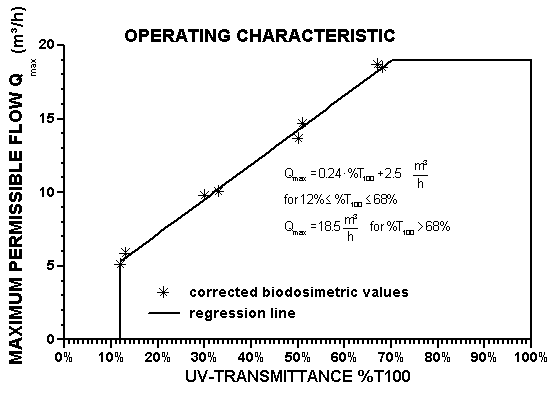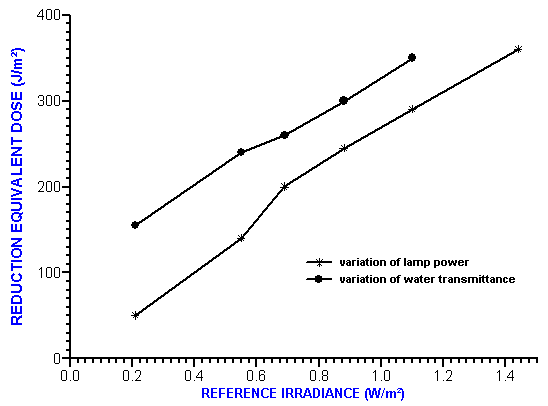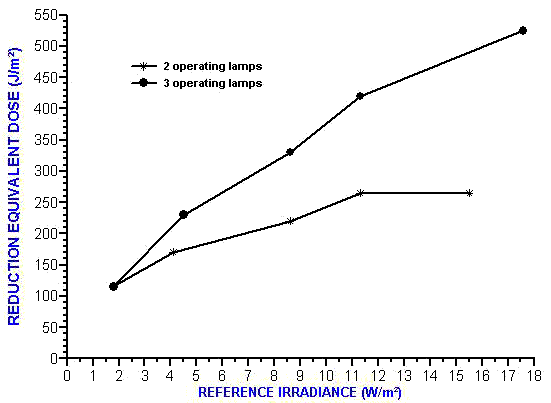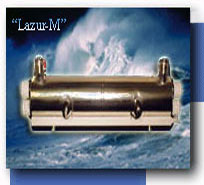The disinfection of water with Ultraviolet radiation and
type-testing of Ultraviolet-disinfection plants for drinking water 
Alexander Cabaj1, Regina Sommer2
1Institut fur Medizinische Physik und Biostatistik, Veterinarmedizinische Universitat Wien,
2Hygiene-Institut, Universitat Wien
Austria
Poster presented at 24th session of the CIE, June 24-30, 1999 in Warsaw (Poland)
INTRODUCTION
Disinfection of drinking water with Ultraviolet-radiation has been put on a new basis in Austria: each new plant must be prototype tested following the Austrian Standard ONORM M 5873. A minimum Reduction Equivalent Dose (RED) of 400 J/m2 of radiation with wavelength 253.7 nm is required which must be proven with a biodosimeter of defined Ultraviolet-susceptibility.
In addition a Ultraviolet-sensor with absolute calibration for irradiance in W/m2 is necessary which measures the reference irradiance and a minimum reference irradiance must be kept in. For type-testing the water flowing into the disinfection plant is seeded with microorganisms and Ultraviolet-transmission is regulated in adding sodium-thiosulphate. In flow through systems the resulting RED can be strongly influenced by dose distributions among the microorganisms after irradiation. If the hydraulic behaviour of the plant is not optimized significant dose distributions occur which reduce the RED. At present biodosimetry is the only method to measure the efficiency of a Ultraviolet-disinfection plant for drinking water.
MATERIALS AND METHODS As biodosimeter spores of Bacillus subtilis ATCC 6633 (cultivation method described in Sommer and Cabaj, 1993) were used which were calibribated with respect to their Ultraviolet-susceptibility at 253.7 nm in a laboratory irradiation device with quasi parallel radiation from mercury low pressure lamps. Ultraviolet fluence was measured with a radiometer from International Light (IL1700 with Detector SED240, interference filter NS254 and W entrance optics), corrections for reflexion at the surface of the suspension and absorbance in the suspension were made.
The calibrated spores were added to the water flowing into the disinfection plant and their concentration was determined before and after irradiation. In addition to the spores sodium-thiosulfate was added to the water in order to reduce water transmittance to an appropriate value. Static mixers were used to achieve homogeneous concentrations of spores and of Ultraviolet-absorbing sodium-thiosulphate.
In general every microorganism having passed a Ultraviolet-disinfection plant receives fluences different from the other ones, therefore a distribution of fluences exists among the microorganisms which have passed through. The result of such measurements is the Reduction Equivalent Dose (RED) which in general is lower than the arithmetic mean of the distribution of fluences (Cabaj et al., 1996a and Cabaj et al., 1996b)
Parts of the experiments were performed in the Austrian Research and Testing Centre Arsenal in Vienna, Austria.
RESULTS
25 commercial disinfection plants have been type-tested till now and severe differences between the RED calculated by the manufacturer and the measured values were determined in several cases.
For the tested units we measured at varying water-flows (m3/h), Ultraviolet-transmittances of the water and lamp powers which are expressed as the reference irradiances measured with a Ultraviolet-sensor. In fig. 1 an example of these results is given. The tests were performed at reduced lamp power equivalent to an aged lamp at the end of its usable life-time. 
Fig. 1: Permissible maximum flow in a certain disinfection plant in dependence from Ultraviolet-transmittance (100 mm path length) of the water, tested with biodosimeter. If the operating parameters lie within the indicated field a RED of at least 400 J/m2 is guaranteed. If differences between the measured RED and the minimum RED of 400 J/m2 were measured, the maximum permissible flow had to be corrected invers-proportionally. Another possibility to correct for this deviation would be to increase the lowest permissible reference irradiance. These two methods nearly give the same results but if the curves which are used for the determination of the lay out are non-linear minor differences exist.
Further experiments were performed in order to investigate if the Ultraviolet-power of the lamp and the Ultraviolet-transmittance of the water influence the RED to the same extent or if differences exist (Sommer et al. 1997). A plant with a single Ultraviolet-lamp and a second one with 3 lamps were tested. A defined reference irradiance was achieved on the one hand in varying lamp power and using water with constantly high Ultraviolet-transmittance and on the other hand in keeping lamp power constant on its highest possible value and reducing water trans-mittance. In the plant with one single lamp variation of Ultraviolet-power had much more influence on the RED than variation of transmittance when the same reference irradiance was measured (fig. 2). In a disinfection plant with 3 lamps the RED was determined in one case with all 3 lamps operating and in a second experiment with one lamp switched off, which of course gave worse results at same reference irradiance (fig. 3). 
Fig. 2: RED in dependance from reference irradiance at varying transmittance and at constant lamp power (upper curve). RED in dependance from reference irradiance at varying lamp power and at constant transmittance (lower curve).

Fig. 3: RED in dependance from reference irradiance with 3 (upper curve) or 2 (lower curve) operating lamps at varying lamp power and at constant transmittance. (%T100=11%, flow rate 6 m3/h).
DISCUSSION
Biodosimetry of Ultraviolet-disinfection plants for drinking water has established as standard method in this field. It is the only method which enables to measure the mean fluence in the plant at all operating conditions. Even smaller effects like the influence of radiation reflected by the inner walls of the disinfection plant can be measured (Sommer et al., 1996c). Because the inactivation of microorganisms is the aim of disinfection plants the application of a biodosimetric test in a bioassay results in ideal control over the complicated processes which occur during the passing of the microorganisms in a turbulent flow through the inhomogeneous radiation field inside the Ultraviolet-plant.
REFERENCES
Sommer R., A. Cabaj (1993) Evaluation of the efficiency of a Ultraviolet plant for drinking water disinfection. Wat. Sci. Tech. 27 , 357 – 362.
Cabaj A., R. Sommer, D. Schoenen (1996a) Biodosimetry: model calculations for u.v. water disinfection devices with regard to dose distributions. Wat. Res. 30 , 1003-1009.
Cabaj A., R. Sommer, M. Kundi (1996b) The influence of dose distributions on the result of Ultraviolet-biodosimetry. Proceedings IRPA9 1996, International Congress on Radiation Protection, Vienna, Austria, April 14-19, 1996, Volume 3, 652-654.
Sommer R., A. Cabaj, T. Haider (1996c) Microbicidal effect of reflected Ultraviolet radiation in devices for water disinfection. Wat. Sci. Tech. 34 , 173-177.
Sommer R., A. Cabaj, W. Pribil, T. Haider (1997) Influence of lamp intensity and water transmittance on the Ultraviolet disinfection of water. Wat. Sci. Tech. 35 , 113-118.
ADRESS
Dipl.-Ing. Alexander Cabaj, Institut fur Medizinische Physik und Biostatistik, Veterinarmedizinische Universitat Wien, A 1210 Wien, Veterinarplatz 1. Tel.: +43-1-25077-4322, Fax: +43-1-25077-4390,
e-mail: alexander.cabaj@vu-wien.ac.at


|




